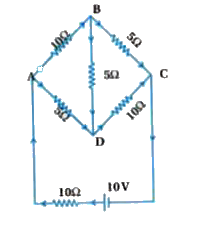Prove that, if an insulated, uncharged conductor is placed near a charged conductor and no other conductors are present, the uncharged body must be intermediate in potential between that of the charged body and that of infinity. Solution in Gujrati
The electric field E=−dVdr suggests that electric potential decreases along the direction of the field.
Let us take any path from the charged conductor to the uncharged conductor along the direction of electric field. Therefore, the electric potential decrease along this path.
Now, another path from the uncharged conductor to infinity will again continually lower the potential further. This ensures that the uncharged body must be intermediate in potential between that of the charged body and that of infinity.
Topper's Solved these Questions
- BOOK - KUMAR PRAKASHANCHAPTER - ELECTROSTATIC POTENTIAL AND CAPACITANCEEXERCISE - Section C ( NCERT Exemplar Solution ) ( Long Answer Type Questions )12videos
ELECTROSTATIC POTENTIAL AND CAPACITANCE
- BOOK - KUMAR PRAKASHANCHAPTER - ELECTROSTATIC POTENTIAL AND CAPACITANCEEXERCISE - Section D ( Multiple Choice Questions (MCQs) )93videos
ELECTROSTATIC POTENTIAL AND CAPACITANCE
- BOOK - KUMAR PRAKASHANCHAPTER - ELECTROSTATIC POTENTIAL AND CAPACITANCEEXERCISE - Section C ( NCERT Exemplar Solution ) ( Very Short ,Aswer Type Questions )5videos
ELECTROSTATIC POTENTIAL AND CAPACITANCE
- BOOK - KUMAR PRAKASHANCHAPTER - ELECTROMAGNETIC WAVESEXERCISE - BOARD.S QUESTION PAPER MARCH - 2020 (PART - B) SECTION - C5videos
ELECTROMAGNETIC WAVES
- BOOK - KUMAR PRAKASHANCHAPTER - MAGNETISM AND MATTEREXERCISE - SECTION D Multiple Choice Questions (MCQs) (MCQs asked in Competitive Exams) MCQs asked in Board Exam and GUJCET7videos
MAGNETISM AND MATTER
Similar Questions
Find the equation of the equipotential for an infinite cylinder of radius r0 carrying charge of linear density λ.
02:21View SolutionWhen a unit positive charge moves from one point to another point in an electric field, work done on it ......
02:04View SolutionConsider two conducting spheres of radii R1 and R2 with R1>R2. If the two are at the same potential, the larger sphere bas more charge than the smaller sphere. State whether the charge density of the smaller sphere is more or less than that of the larger one.
01:59View SolutionDetermine the current in each branch of the given network.
 03:13View Solution
03:13View SolutionAt a place on earth the vertical component of earth's magnetic field is √3 times its horizontal component. The angle of dip at this place is …...
03:24View SolutionAn uncharged conductor A is brought near a positively charged conductor B. The size of the conductor A is much greater than the size of conductor B. Then,
01:42View SolutionAn uncharged insulated conductor A is brought near a charged insulated condutor B. what happens to charge and potential of B ?
02:09View SolutionProve that, if an insulated, uncharged conductor is placed near a charged conductor and no other conductors are present, the uncharged body must be intermedicate in potential between that of the charged body and that of infinity.
02:00View SolutionIf a charged body is placed near a neutral conductor, will it attract the conductor or repel it ?
01:31View SolutionThe process due to which an uncharged insulated metallic conductor gets electrically charged when held near a charged body is called ______.
02:04View Solutionजब किसी अनावेशित चालक को किसी आवेशित चालक के पास लाया जाता है तो उसका विभव घट जाता है |
01:59View Solutionधनावेशित काँच की छड़ को अनावेशित चालक के समीप लाया जाता है। छड़ का आवेश :
02:26View Solutionएक अनावेशिक विद्युतक्रीड़ित चालक (uncharged insulated conductor) A को एक आवेशित विद्युत्रोधित चालक (charged insulated conductor) B के निकट लाया जाए, तो B के आवेश और विभव में किस प्रकार का परिवर्तन होगा?
02:22View SolutionAn uncharged conductor is brought in contact with a positively charged body. What is the nature of charge acquired by the conductor?
02:49View SolutionAn uncharged insulated conductor A is brought near a charged insulated condutor B. what happens to charge and potential of B ?
03:23View Solution

